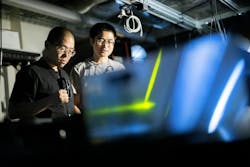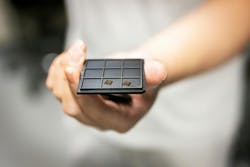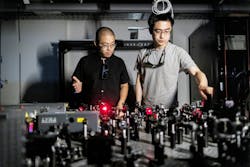‘Photonic crystal highway’ guides light forward on chips
Guiding photons through fiber optics or photonic chips—optical mazes—is a serious challenge because they tend to scatter, split, or become absorbed along the route. A new approach to the problem by University of Pennsylvania researchers led to a system that guides light from Point A to B—essentially a secret tunnel for photons—without any loss of photons.
Their approach involves shining polarized light on a photonic crystal, a semiconductor patterned with tiny holes to create a topological state, which was created by Bo Zhen, an associate professor of physics; Li He, a postdoctoral researcher; and Eugene Mele, a physics professor known for his work helping discover electronic topological insulators. One of their primary goals was to guide the light inside a chip to move along its edges in a forward-only direction.
“In optics, especially integrated photonics, light often gets scattered by tiny fabrication defects, which causes backscattering—like cars getting stuck within a maze,” says Zhen. “We wanted to change the rules of the maze so light naturally takes a one-way protected route that ignores bumps and detours. Our idea was to experimentally achieve a topological phase of light—a Floquet Chern insulator—on a nonlinear photonic crystal platform and use it to build robust ‘highways’ for photons (see Fig. 1).”
The team’s work opens the door to outmaneuvering chip defects by routing light around them, optical isolators that won’t require bulky magnets, and lasers that emit light in a forward-only direction. Telecommunications, sensing, and quantum technologies are likely to benefit (see video).
A little background/key concepts
Photonic crystals “are semiconductor slabs patterned with (periodic) holes or structures, which allow us to shape the way light flows inside the materials. It really is quite amazing, where a simple piece of transparent glass (due to patterning) can be perfectly reflective, like a mirror,” says Zhen.
A Chern insulator for light is a topological phase and a nonzero Chern number supports chiral edge states—unidirectional channels are immune to backscattering from disorder.
The team uses Floquet driving—strong ultrafast lasers (pump) to periodically drive the system—because it allows them to modify the linear band structure and engineer effective band structures not available within static materials.
Their work also involves nonlinear optics. “The strong pump laser changes the optical properties and mixes different frequencies together so we can see red light going in but blue light coming out,” explains Zhen. “Using this nonlinear effect, we can directly observe a Floquet band hybridize and a Chern insulator gap being opened and closed.”
A photonic crystal approach
The team fabricates aluminum gallium arsenide (AlGaAs) photonic crystals (see Fig. 2) and illuminates them with an ultrafast optical drive, while a second ultrafast pulse probes and reads out the spectrum (see Fig. 3). “Our laser system is based on ultrafast optical oscillators and optical parametric amplifiers in ytterbium. It’s manufactured by Light Conversion,” says Zhen.
When the pump laser was circularly polarized, time reversal symmetry (in which behavior remains the same whether time runs forward or backward) was broken and a topological gap was opened (with Chern number C=1). “On the other hand, when the pump laser is linearly polarized the gap remains closed,” Zhen says. “Essentially, we verified all of this by reconstructing the Floquet band structure from transient spectroscopy measurements.”
As you can imagine, a few moments really stood out for the team during this work. “The first one was that when we changed the pump polarization from linear to circular, we saw the gapless spectrum change into a gapped spectrum, which is a clean demonstration of the topological phase transition,” says Zhen. “And the second was seeing the measured Floquet spectra line up with our calculations and predictions from five or six years ago. It was a genuine ‘Eureka!’ moment.”
Three challenges: Laser, sample, measurement
Along the way, the researchers also faced three different types of challenges to overcome. First, the laser system was heavily customized, “so we need a very strong laser in a less common wavelength regime (mid-infrared), and a rather long pulse duration (at least to the standard of current ultrafast lasers),” says Zhen. “It involved a lot of planning and the great abilities of Light Conversion to deliver it.”
The sample itself was also a challenge. “Fabrication of a high-quality AlGaAs photonic crystal on the substrate of silicon oxide (SiO2) with well-controlled dispersion was very challenging for us,” he adds.
And then the measurement required performing transient spectroscopy with enough resolution in frequency and in space domains, and being able to extract the Floquet band structures from the measured results—which were difficult as well.
Topological protection of optical signals
What does this work mean for the field of nanophotonics and PICs, and optical comms and quantum applications? “It offers a broad and general method to add topological protection of optical signals,” says Zhen. “Furthermore, it can be implemented ‘on demand’ by shining another laser at it—rather than relying on magnets or exotic media. In terms of potential applications, I think it can eventually enable one-way routing on chips to tolerate bends and defects, which means more forgiving PIC designs and higher yield. Furthermore, it can provide a pathway to protect fragile quantum states of light and reduce decoherence in quantum photonics. Of course, there is still significant work ahead of us before these ideas can become reality.”
In the near term, “we aim to scale the concept to different frequency ranges, such as microwave and telecom, as well as on-chip integration,” Zhen says.
Looking farther down the road, Zhen’s team is also exploring the possibilities of extending their concept into 3D photonic structures (from the current 2D geometry), as well as quantum state protection (beyond the classical transport measurements they performed).
FURTHER READING
J. Jin et al., Nat. Nanotechnol. (2025); https://doi.org/10.1038/s41565-025-02003-1.
About the Author
Sally Cole Johnson
Editor in Chief
Sally Cole Johnson, Laser Focus World’s editor in chief, is a science and technology journalist who specializes in physics and semiconductors.



